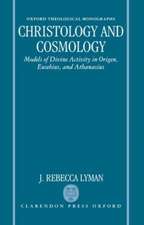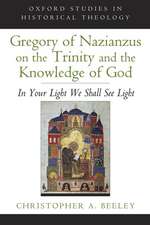Resurrecting Parts: Early Christians on Desire, Reproduction, and Sexual Difference: Routledge Studies in the Early Christian World
Autor Taylor Petreyen Limba Engleză Paperback – 12 dec 2019
Resurrecting Parts is the first study to examine the place of gender and sexuality in early Christian debates on the nature of resurrection, investigating how the resurrected body has been interpreted by writers of this period in order to address the nature of sexuality and sexual difference. In particular, Petrey considers the instability of early Christian attempts to separate maleness and femaleness. Bodily parts commonly signified sexual difference, yet it was widely thought that future resurrected bodies would not experience desire or reproduction. In the absence of sexuality, this insistence on difference became difficult to maintain. To achieve a common, shared identity and status for the resurrected body that nevertheless preserved sexual difference, treatises on the resurrection found it necessary to explain how and in what way these parts would be transformed in the resurrection, shedding all associations with sexual desires, acts, and reproduction.
Exploring a range of early Christian sources, from the Greek and Latin fathers to the authors of the Nag Hammadi writings, Resurrecting Parts is a fascinating resource for scholars interested in gender and sexuality in classical antiquity, early Christianity, asceticism, and, of course, the resurrection and t
| Toate formatele și edițiile | Preț | Express |
|---|---|---|
| Paperback (1) | 389.38 lei 43-57 zile | |
| Taylor & Francis – 12 dec 2019 | 389.38 lei 43-57 zile | |
| Hardback (1) | 1050.78 lei 43-57 zile | |
| Taylor & Francis – 27 iul 2015 | 1050.78 lei 43-57 zile |
Din seria Routledge Studies in the Early Christian World
-
 Preț: 279.03 lei
Preț: 279.03 lei -
 Preț: 310.51 lei
Preț: 310.51 lei -
 Preț: 311.07 lei
Preț: 311.07 lei -
 Preț: 312.97 lei
Preț: 312.97 lei -
 Preț: 416.22 lei
Preț: 416.22 lei -
 Preț: 384.66 lei
Preț: 384.66 lei -
 Preț: 389.66 lei
Preț: 389.66 lei -
 Preț: 382.54 lei
Preț: 382.54 lei - 21%
 Preț: 258.15 lei
Preț: 258.15 lei -
 Preț: 382.18 lei
Preț: 382.18 lei -
 Preț: 395.47 lei
Preț: 395.47 lei -
 Preț: 380.45 lei
Preț: 380.45 lei -
 Preț: 381.81 lei
Preț: 381.81 lei - 16%
 Preț: 261.73 lei
Preț: 261.73 lei - 29%
 Preț: 787.71 lei
Preț: 787.71 lei -
 Preț: 387.96 lei
Preț: 387.96 lei -
 Preț: 391.79 lei
Preț: 391.79 lei
Preț: 389.38 lei
Nou
Puncte Express: 584
Preț estimativ în valută:
74.51€ • 78.00$ • 61.65£
74.51€ • 78.00$ • 61.65£
Carte tipărită la comandă
Livrare economică 07-21 aprilie
Preluare comenzi: 021 569.72.76
Specificații
ISBN-13: 9780367873219
ISBN-10: 0367873214
Pagini: 136
Dimensiuni: 156 x 234 x 7 mm
Greutate: 0.45 kg
Ediția:1
Editura: Taylor & Francis
Colecția Routledge
Seria Routledge Studies in the Early Christian World
Locul publicării:Oxford, United Kingdom
ISBN-10: 0367873214
Pagini: 136
Dimensiuni: 156 x 234 x 7 mm
Greutate: 0.45 kg
Ediția:1
Editura: Taylor & Francis
Colecția Routledge
Seria Routledge Studies in the Early Christian World
Locul publicării:Oxford, United Kingdom
Cuprins
Introduction: With What Kind of Body Do They Come?
1. Angels, Virgins, and Mules: Pseudo-Justin Martyr, On the Resurrection
2. Spiritual Resurrection in the Flesh: The Nag Hammadi Treatise on the Resurrection
3. "The Practice of Every Virtue": Athenagoras, On the Resurrection
4. "As a Bridegroom with a Bride": Irenaeus, Against Heresies
5. Flesh and Female: Tertullian of Carthage
Conclusion: Parts and the Foundations of Flesh
1. Angels, Virgins, and Mules: Pseudo-Justin Martyr, On the Resurrection
2. Spiritual Resurrection in the Flesh: The Nag Hammadi Treatise on the Resurrection
3. "The Practice of Every Virtue": Athenagoras, On the Resurrection
4. "As a Bridegroom with a Bride": Irenaeus, Against Heresies
5. Flesh and Female: Tertullian of Carthage
Conclusion: Parts and the Foundations of Flesh
Recenzii
"Petrey deftly maps the complex landscape of second-century Christian speculations on sexual difference and the resurrection body. Focusing on the vexed place of those bodily “parts” that mark the body as female or male in theories of bodily resurrection, Petrey’s study persuasively demonstrates how this seemingly rarefied theological question in fact condenses a broad range of conceptual issues that attend early Christian thinking about the nature of bodies, gender, desire, and sexual practice. Resurrecting Parts is a welcome and significant contribution to both early Christian studies and the history of ancient sexuality." - Benjamin H. Dunning, Fordham University, USA
"This book is an elegant and erudite study of bodily resurrection among early Christian authors, with respect to the question of gender and sexuality. Eschewing historiographical models which reproduce the discourse of orthodoxy and heresy, Petrey reads the Treatise on the Resurrection alongside Irenaeus and other early Christian sources, asking not whether a source embraces or rejects bodily resurrection, but rather what kind of body is imagined. The answers are complex and fascinating. This work should be read by all students of early Christianity interested in how the resurrected body was mobilized to tell the truth about the sexual self." - Shelly Matthews, Texas Christian University, USA
"Overall, Petrey accomplishes his goals for demonstrating that theologians in the 2nd century had multiple views on how to solve the issue of bodily resurrection, and that these views largely maintained sexual difference as the central location of embodied identity while disposing of sexual desire and acts in the resurrected bodies.[...] Furthermore, it is helpful for anyone interested either in ancient Christian discourse about the resurrection or views on sex and sexuality."
-Kathryn Phillips, Religious Studies at the University of California, Riverside, Reading Religion
"This book is an elegant and erudite study of bodily resurrection among early Christian authors, with respect to the question of gender and sexuality. Eschewing historiographical models which reproduce the discourse of orthodoxy and heresy, Petrey reads the Treatise on the Resurrection alongside Irenaeus and other early Christian sources, asking not whether a source embraces or rejects bodily resurrection, but rather what kind of body is imagined. The answers are complex and fascinating. This work should be read by all students of early Christianity interested in how the resurrected body was mobilized to tell the truth about the sexual self." - Shelly Matthews, Texas Christian University, USA
"Overall, Petrey accomplishes his goals for demonstrating that theologians in the 2nd century had multiple views on how to solve the issue of bodily resurrection, and that these views largely maintained sexual difference as the central location of embodied identity while disposing of sexual desire and acts in the resurrected bodies.[...] Furthermore, it is helpful for anyone interested either in ancient Christian discourse about the resurrection or views on sex and sexuality."
-Kathryn Phillips, Religious Studies at the University of California, Riverside, Reading Religion
Descriere
This study is the first to examine the question of gender and sexuality in early Christian debates on the nature of the resurrection. It is concerned with how early Christians, from Greek and Latin fathers to the authors of the Nag Hammadi writings, interpreted the resurrected body to address questions about the nature of sexuality and sexual di



















